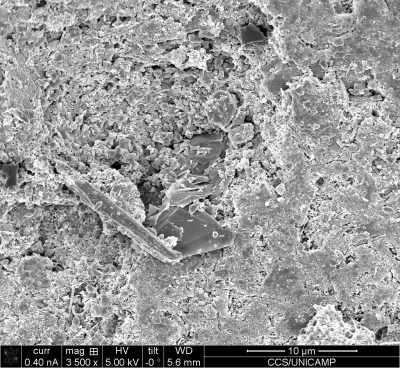[Paper: Enhanced properties of cement mortars with multilayer graphene nanoparticles. Rodrigo Alves e Silva, Paulo de Castro Guetti, Mário Sérgio da Luz, Francisco Rouxinol, Rogério Valentim Gelamo. Construction and Building Materials. Volume 149, 15. September 2017, pages 378-385. https://doi.org/10.1016/j.conbuildmat.2017.05.146]
Graphene nanoflakes for a super-resistant mortar

Researchers from Brazilian institutions added nanometric graphene flakes to cement mortar and obtained a composite with resistance of almost 150% higher than that of conventional mortar. By means of simpler, faster and cheaper processes than previously reported in the scientific literature, the team created a reinforced mortar ready for use in civil construction. The work was reported in a paper that has just been published in a journal of the Elsevier publishing house dedicated to investigation and innovative use of materials in construction and repair, Construction and Building Materials (impact factor: 3.169).
Compared to traditional mortar, the new graphene-reinforced mortar can be used in smaller amounts and is less likely to crack over time, explains Professor Rogério Valentim Gelamo, the corresponding author of the article. Moreover, its manufacturing process poses no health or environmental risks and no further procedure is required for its complete handling and application.
Professor Gelamo believes that the powder-based multilayer graphene nanoflakes could be sold in ampoules with the required quantity to be added to 1 cubic meter of mortar. The reinforced mortar would cost around U$ 5 more per cubic meter. “The cost is really low and it could be applied or marketed by a company interested in this, since the large-scale manufacturing is already proficient in our Laboratory of Thin Films and Plasma Processes of the Federal University of Triângulo Mineiro (UFTM) in the city of Uberaba” declares Professor Gelamo.
The idea of this work came about when Gelamo decided to look for applications for the multilayer graphene he had developed during his post-doctorate at the Center for Semiconductor Components from the State University of Campinas (Unicamp), along with Francisco Rouxinol, also a postdoc. The material and its process have already been the object of papers and a patent. In 2010, Gelamo became adjunct professor of the newly created Institute of Technological and Exact Sciences at UFTM. There, teaching in the first Civil Engineering course, Professor Gelamo met the undergraduate student Rodrigo Alves e Silva, who was enthusiastic with the idea of using multilayer graphene in the mortar. Another professor of UFTM, Paulo Guetti, joined them. “Together we carried out the first experiments with these composites, which to our surprise gave excellent results in the first tests,” recalls Professor Gelamo.
The multilayer graphene was obtained from graphite flakes donated by the Brazilian National Grafite company. Using isopropyl alcohol the researchers extracted nanoflakes formed by a maximum of 40 superimposed graphene layers, each one an atom thick, with total thickness of 0.7 nm to 20 nm. The result: multilayer graphene nanoflakes with almost no defects, in the form of powder ready to be dispersed in the mortar. The underlying idea of our work was to use graphene multilayers obtained by simpler, faster and cheaper processes than those used to obtain oxidized and chemically reduced graphene. This enabled to combine practicality and economy with the excellent thermal and mechanical properties of the graphene layers,” says Gelamo. “The way graphene is currently obtained (Hammer or similar method) creates many defects in the graphene structure, which ends up compromising its properties,” he adds.
In the second step, the scientists prepared mortar with the conventional water, cement and sand ratio, and reinforced it with five different percentages of multilayer graphene nanoflakes, ranging from 0% (mortar without graphene) to 0.033%. “Our dispersion was also performed in an innovative and simple way, using only organic solvents mixed directly on the still dry mortar composite,” reports Professor Gelamo. The team was then able to obtain a mixture without the graphene agglomerations that are cited in most articles on cement and graphene composites.
With the five types of mortar, the team prepared cylindrical samples 5 cm in diameter and 10 cm long and tested their compressive and tensile strengths. The tests were performed 3, 7, and 28 days after the mortar preparation, following the respective standards of the Brazilian Association of Technical Standards (ABNT). All tests showed significant increases in mortar strength when reinforced with the multilayer graphene. In particular, the best tensile strength test result was obtained with samples containing the highest percentage of graphene, 7 days after its manufacture: 144.4% increase in strength compared to conventional mortar samples. As for the compressive strength, the best result (an increase of 95.7%) was achieved with the addition of 0.021% of multilayer graphene, 28 days after the mortar preparation.
The morphology and composition of the samples and the materials used in their manufacture were analyzed using several techniques. These analyses helped the team understand why adding multilayer graphene nanoflakes resulted in such significant mortar strength increases. According to the authors of the article, the presence of this graphene accelerates the hydration reaction of the mortar, generating changes in its structure and composition which in turn improve the propagation of internal stresses through the material, thereby helping to prevent the occurrence of cracks.
Notwithstanding the success obtained by applying the multilayer graphene in the mortar, Professor Gelamo continues looking for other applications for his graphene nanoflakes through partnerships with Brazilian and international groups. “We have used multi-layer graphene in field-emitting devices, batteries, flexible and self-supporting supercapacitors, chemical and biological sensors, nanofluids for machining, and other applications,” he says. “We have also functionalized the graphene multilayers with reactive plasmas in order to change the properties of these materials, with some works already published,” he adds.
The research that originated the Construction and Building Materials article was carried out with financial support from Brazilian agencies CNPq, Capes and Fapemig.

